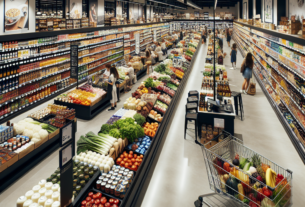Introduction
Digital menus are revolutionizing the dining experience across the foodservice industry. With advancements in technology, restaurants are increasingly adopting digital menu boards to enhance customer engagement, improve operational efficiency, and drive sales. In this report, we will delve into the impact of digital menus on the dining experience, exploring the latest trends, challenges, and innovations in the foodservice industry.
Market Overview
The global digital menu market is experiencing rapid growth, fueled by the increasing adoption of digital signage solutions in the foodservice industry. According to a report by Market Research Future, the digital menu market is projected to reach $6.4 billion by 2025, with a CAGR of 8.2% from 2020 to 2025.
Key Players
Some of the key players in the digital menu market include:
1. Samsung Electronics
2. LG Electronics
3. Panasonic Corporation
4. NEC Corporation
5. Sharp Corporation
These companies offer a wide range of digital menu solutions, ranging from interactive touch screen displays to cloud-based digital signage platforms.
Market Share
Samsung Electronics and LG Electronics are leading the digital menu market, with a combined market share of over 50%. These companies have established themselves as industry leaders in providing innovative digital signage solutions for the foodservice industry.
Market Volumes
The demand for digital menu boards is on the rise, with an increasing number of restaurants, cafes, and fast-food chains investing in digital signage solutions. The market volumes for digital menu boards are expected to grow significantly in the coming years, driven by the need for interactive and engaging customer experiences.
Benefits of Digital Menus
Digital menus offer a wide range of benefits for both customers and restaurant operators. Some of the key benefits include:
1. Enhanced Customer Engagement: Digital menus provide a visually appealing and interactive way for customers to explore menu items, promotions, and special offers.
2. Improved Operational Efficiency: Digital menus can be easily updated in real-time, allowing restaurants to make changes to menu items, prices, and promotions quickly and efficiently.
3. Increased Sales: Studies have shown that digital menus can lead to an increase in sales by up to 20% due to upselling, cross-selling, and targeted promotions.
4. Cost Savings: Digital menus eliminate the need for printing and distributing traditional menus, saving restaurants time and money in the long run.
Challenges and Considerations
While digital menus offer many benefits, there are also challenges and considerations that restaurant operators need to keep in mind when implementing digital signage solutions. Some of the key challenges include:
1. Initial Investment: The upfront cost of installing digital menu boards can be significant, especially for small and independent restaurants.
2. Technical Issues: Digital menus rely on technology, which can sometimes experience technical issues such as connectivity issues, software glitches, and hardware malfunctions.
3. Training and Support: Restaurant staff may require training to operate and maintain digital menu boards effectively. Additionally, ongoing technical support may be needed to address any issues that arise.
4. Content Management: Managing content on digital menus can be time-consuming and require dedicated resources to ensure that menus are up-to-date and accurate.
Innovations in Digital Menus
To overcome these challenges and enhance the dining experience, many restaurants are leveraging innovative digital menu solutions. Some of the latest innovations include:
1. Personalization: Using customer data and analytics, restaurants can personalize digital menus to showcase recommended items based on past preferences and purchase history.
2. Integration with Mobile Ordering: Digital menus can be integrated with mobile ordering apps, allowing customers to place orders directly from the menu board using their smartphones.
3. Augmented Reality: Some restaurants are incorporating augmented reality technology into digital menus, allowing customers to visualize menu items in 3D before placing their orders.
4. Sustainability: Digital menus are environmentally friendly, as they eliminate the need for paper menus and reduce waste. Restaurants can also showcase their commitment to sustainability through digital signage solutions.
Future Outlook
The future of digital menus looks promising, with continued innovation and advancements in technology driving the adoption of digital signage solutions in the foodservice industry. As restaurants strive to enhance the dining experience and stay competitive in a rapidly evolving market, digital menus will play a crucial role in shaping the future of the restaurant industry.
In conclusion, digital menus are changing the dining experience by providing interactive, engaging, and personalized menu solutions that enhance customer satisfaction and drive sales. With the increasing adoption of digital signage solutions in the foodservice industry, restaurants are poised to leverage the benefits of digital menus to stay ahead of the competition and meet the evolving needs of today’s tech-savvy consumers.



